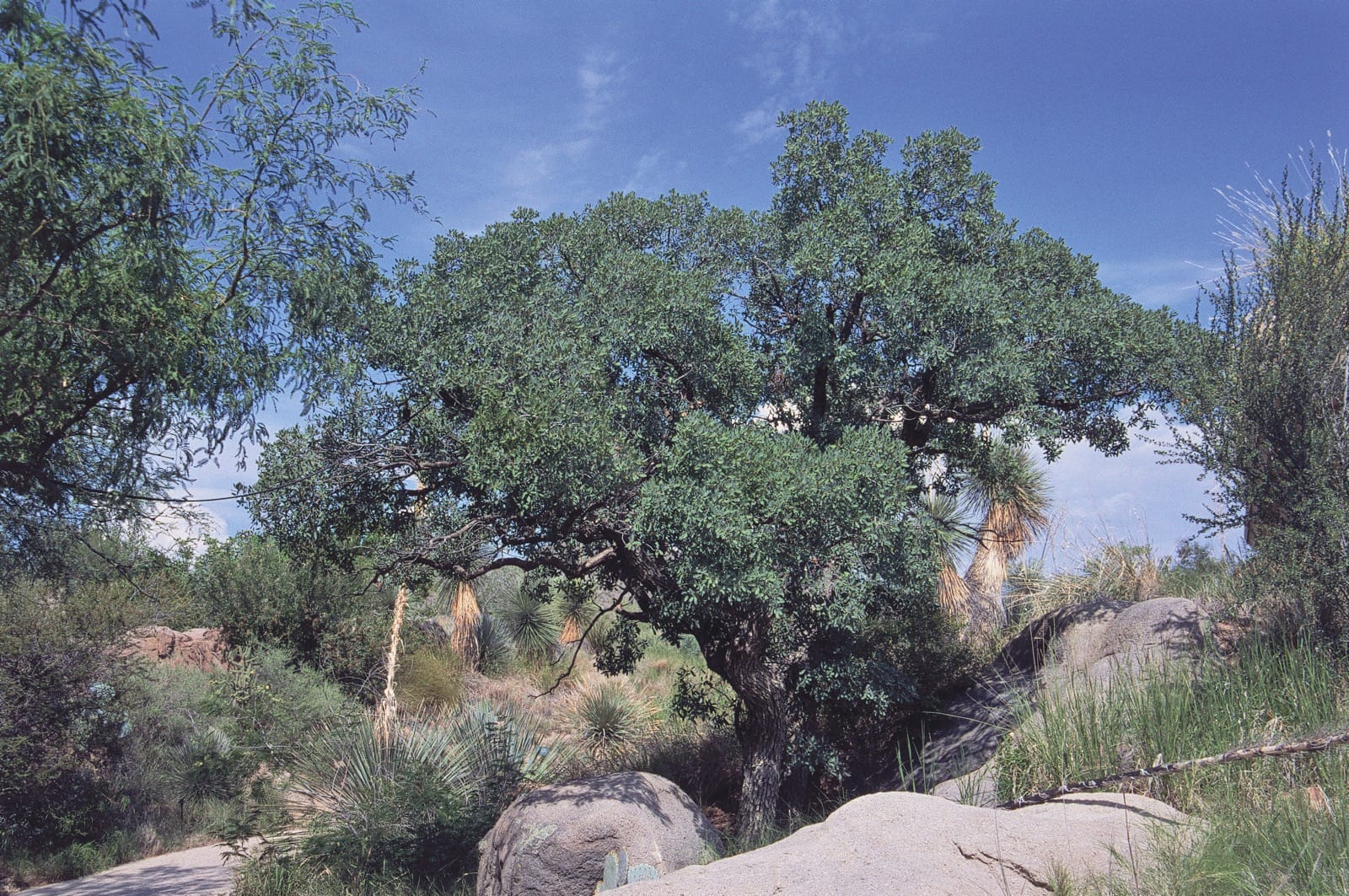Quercus turbinella
Sponsor
Kindly sponsored by
The Trees and Shrubs Online Oak Consortium
Credits
Article from New Trees by John Grimshaw & Ross Bayton
Recommended citation
'Quercus turbinella' from the website Trees and Shrubs Online (treesandshrubsonline.
Genus
- Quercus
- Subgen. Quercus, Sect. Quercus
Common Names
- Sonoran Scrub Oak
- Scrub Live Oak
Other taxa in genus
- Quercus acerifolia
- Quercus acherdophylla
- Quercus acrodonta
- Quercus acuta
- Quercus acutifolia
- Quercus acutissima
- Quercus afares
- Quercus affinis
- Quercus agrifolia
- Quercus alba
- Quercus aliena
- Quercus alnifolia
- Quercus aquifolioides
- Quercus arizonica
- Quercus arkansana
- Quercus aucheri
- Quercus augustini
- Quercus austrina
- Quercus × auzendei
- Quercus baloot
- Quercus bambusifolia
- Quercus baronii
- Quercus bicolor
- Quercus brantii
- Quercus buckleyi
- Quercus canariensis
- Quercus canbyi
- Quercus candicans
- Quercus castanea
- Quercus castaneifolia
- Quercus cerris
- Quercus chenii
- Quercus chrysolepis
- Quercus coccifera
- Quercus cocciferoides
- Quercus coccinea
- Quercus conspersa
- Quercus crassifolia
- Quercus crassipes
- Quercus delavayi
- Quercus dentata
- Quercus deserticola
- Quercus dolicholepis
- Quercus douglasii
- Quercus dumosa
- Quercus durifolia
- Quercus eduardii
- Quercus ellipsoidalis
- Quercus emoryi
- Quercus engelmannii
- Quercus engleriana
- Quercus euboica
- Quercus eugeniifolia
- Quercus fabri
- Quercus faginea
- Quercus falcata
- Quercus floribunda
- Quercus frainetto
- Quercus franchetii
- Quercus fruticosa
- Quercus fusiformis
- Quercus gambelii
- Quercus garryana
- Quercus geminata
- Quercus georgiana
- Quercus germana
- Quercus gilliana
- Quercus gilva
- Quercus glabrescens
- Quercus glauca
- Quercus graciliformis
- Quercus gravesii
- Quercus griffithii
- Quercus grisea
- Quercus guyavifolia
- Quercus hartwissiana
- Quercus hemisphaerica
- Quercus × hispanica
- Quercus hondae
- Quercus hypargyrea
- Quercus hypoleucoides
- Quercus ilex
- Quercus ilicifolia
- Quercus imbricaria
- Quercus incana
- Quercus infectoria
- Quercus insignis
- Quercus ithaburensis
- Quercus kelloggii
- Quercus × kewensis
- Quercus kiukiangensis
- Quercus laceyi
- Quercus laevis
- Quercus lamellosa
- Quercus lanata
- Quercus lancifolia
- Quercus laurifolia
- Quercus laurina
- Quercus × leana
- Quercus leucotrichophora
- Quercus × libanerris
- Quercus libani
- Quercus lobata
- Quercus lobbii
- Quercus lodicosa
- Quercus longinux
- Quercus longispica
- Quercus look
- Quercus × ludoviciana
- Quercus macranthera
- Quercus macrocalyx
- Quercus macrocarpa
- Quercus macrolepis
- Quercus marilandica
- Quercus mexicana
- Quercus michauxii
- Quercus mongolica
- Quercus monimotricha
- Quercus montana
- Quercus morii
- Quercus muehlenbergii
- Quercus myrsinifolia
- Quercus myrtifolia
- Quercus nigra
- Quercus × numidica
- Quercus oblongifolia
- Quercus obtusata
- Quercus oglethorpensis
- Quercus oxyodon
- Quercus pagoda
- Quercus palmeri
- Quercus palustris
- Quercus pannosa
- Quercus parvula
- Quercus petraea
- Quercus phellos
- Quercus phillyreoides
- Quercus planipocula
- Quercus poilanei
- Quercus polymorpha
- Quercus pontica
- Quercus prinoides
- Quercus pubescens
- Quercus pyrenaica
- Quercus rehderiana
- Quercus reticulata
- Quercus robur
- Quercus rotundifolia
- Quercus rubra
- Quercus rugosa
- Quercus rysophylla
- Quercus sadleriana
- Quercus salicina
- Quercus sartorii
- Quercus × schneideri
- Quercus schottkyana
- Quercus semecarpifolia
- Quercus senescens
- Quercus serrata
- Quercus sessilifolia
- Quercus setulosa
- Quercus shumardii
- Quercus sinuata
- Quercus spinosa
- Quercus stellata
- Quercus stenophylloides
- Quercus suber
- Quercus subspathulata
- Quercus tarokoensis
- Quercus tatakaensis
- Quercus texana
- Quercus tomentella
- Quercus trojana
- Quercus tungmaiensis
- Quercus × turneri
- Quercus undulata
- Quercus utahensis
- Quercus utilis
- Quercus uxoris
- Quercus variabilis
- Quercus velutina
- Quercus virginiana
- Quercus vulcanica
- Quercus warburgii
- Quercus wislizenii
- Quercus xalapensis
Shrub or tree, 5–10 m, occasionally to 20 m. Bark grey, fissured and scaly. Branchlets greyish brown, tomentose to glabrous. Leaves evergreen or partially deciduous, (1.5–)2–3 × 1–1.5(–2) cm, elliptic to ovate, leathery, upper surface glaucous or yellowish and glandular, glabrous or with minute stellate pubescence, lower surface yellowish or reddish and glaucous with minute stellate pubescence, four to eight secondary veins on each side of the midrib, margins with three to five coarse teeth or shallow lobes on each side of the midrib, apex acute to obtuse; petiole 0.1–0.4 cm long. Infructescence 1–4 cm long with one to three cupules. Cupule hemispheric or cup-shaped, 0.8–1.2 × 0.4–0.6 cm; scales ovate, partially tuberculate and covered in greyish or yellowish pubescence. Acorn ovoid, with one-quarter to half of its length enclosed in the cupule, ~2 cm long, stylopodium small. Flowering April, fruiting July (USA). Nixon 1997. Distribution MEXICO: Baja California, Chihuahua, Sonora; USA: Arizona, California, Colorado, New Mexico, Nevada, Texas, Utah. Habitat Dry desert slopes in juniper/pinyon woodland between 800 and 2000 m asl. USDA Hardiness Zone ~5. Conservation status Least Concern. Illustration Nixon 1997, Sternberg 2004; NT755.
Accounted the hardiest of the American evergreen oaks by Sternberg (2004), Quercus turbinella is a species well adapted to its arid hillside habitat, often forming little more than a prickly bush. It was recommended by Melendrez (2000) as an attractive species suitable for planting in cold, dry areas; it thrives in Denver Botanic Gardens, Colorado (A. Coombes, pers. comm. 2008). At Ettelbruck it is hardy but slow-growing, and snow pressure can be a problem for the thin flexible stems (E. Jablonski, pers. comm. 2006). A plant in shade at Chevithorne Barton has reached approximately 3 m. In European collections generally, however, it is rare. In cultivation in North America it hybridises freely with the most disparate-seeming partners, including Q. robur (Sir Harold Hillier Gardens database), and is a parent of several wild hybrids.

